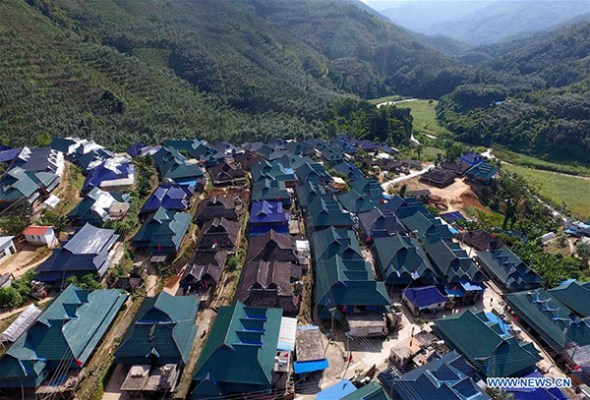
Photo taken on Sep 15, 2017 shows the bird's-eye view of Mannashan Village in Bulangshan Town of Menghai County, Southwest China's Yunnan province. A total of 524 people of the Bulang ethnic group live at the village and most of them have built new houses with the help of government under a policy of poverty alleviation. (Photo/Xinhua)
China's central leadership released on Sunday a package of policies as the "No. 1 Central Document" of the year, charting the road map for rural vitalization.
There is a lot of work to be accomplished in Chinese villages, where opportunities for development have arisen as the country enters a new era, said the document, jointly released by the Central Committee of the Communist Party of China and State Council.
The strategy of rural vitalization was first proposed as one of the major aspects of developing a modernized economy in a report delivered to the 19th CPC National Congress.
In this latest document, the strategy was described as a "historical task" essential to accomplishing China's modernization goals and building a moderately prosperous society.
China cannot become modernized without modernizing its agricultural and rural areas, the document said.
The timetable decided by the CPC at a rural conference in December remains unchanged. But the objectives for different stages have become more specific.
By 2020, the strategy should have established an institutional framework and policy system. By then, no Chinese people will live below the existing poverty line, and rural productivity and agricultural supplies will improve substantially.
By 2035, "decisive" progress will be made, with basic modernization of agriculture and rural areas. All Chinese, either in cities or rural areas, will have equal access to basic public services. Urban and rural integration will improve.
By 2050, rural areas should have strong agriculture, a beautiful countryside and well-off farmers.
The document put a lot of emphasis on the need for proper planning. Local governments have been required to specify their plans according to the local reality, especially for the period from 2018 to 2022, and to coordinate policymaking in relevant spheres.
For instance, in well-developed villages, the priority may be on increasing public services. In villages with a long history and rich natural and cultural resources, development must be done along with protection.
In villages with harsh living conditions and a fragile natural environment, more efforts will be taken toward relocation.
This is the 15th straight year that the "No 1 Central Document" has been devoted to agriculture, farmers and rural areas.
The "No 1 Central Document" is the name traditionally given to the first policy statement of the year released by central authorities and is seen as an indicator of policy priorities.


















































